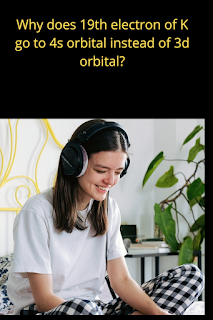Why does 19th electron of K go to 4s orbital instead of 3d orbital? Answer: The 19th electron or last electron of potassium (K) goes to 4s orbital instead of 3d orbital because the energy of 4s orbital is lower than 3d orbital. Explanation: According to Aufbau principal,an electron always goes to lower energy level or orbital first,then goes to higher energy levels or orbitals. The sum of" n+ l "value determines the energy of an orbital.Here, n is the principal quantum number and l is the azimuthal quantum number. For l=0,we get "s" orbital. For l=1,we get "p" orbital. For l=2, we get "d" orbital. Now determine the energy of 4s and 3d orbitals by applying n+l formula. For 4s ,n=4 and l=0 So,n+l is 4+0 =4 For 3d ,n=3 and l=2 So,n+l is 3+2 = 5 Here,we see that the n+l value for 4s is lower than 3d,so 4s has lower energy than 3d orbital.That is why t he 19th electron or last electron of potassium (K) goes t
